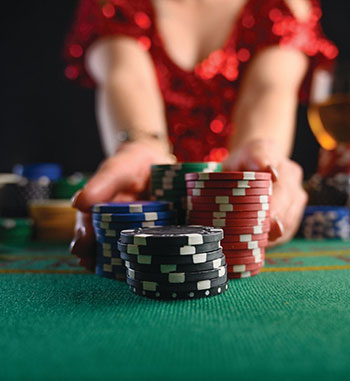AGGRESSIVE POKER PAYS
Raising is the key to gauge the reactions of other players and increase the pot
By Jack Clayton
 We’re always looking to raise our expectations, quality of life, and profit margins. And speaking of profit margins, understanding the ins and outs of raises in poker can help you raise your take at the tables.
We’re always looking to raise our expectations, quality of life, and profit margins. And speaking of profit margins, understanding the ins and outs of raises in poker can help you raise your take at the tables.
For instance, there are different ways to react when someone raises. It depends on the size of the raise and your situation at the table. It’s really a fluid situation that encompasses many facets and variables.
You need to run through these very quickly, of course, before making a move, which takes practice and thought.
How many players are in the pot when the raise is made is one factor. A raise against a single player showcases less card strength than a raise against multiple players. If it’s one-on-one, the player making the raise only has to duel in a solo showdown, meaning they can win with an average hand or be bluffing. However, if they raise with four players involved, they’re step- ping up with likely a much stronger hand, unless they have a pattern of bluffing often, which is why you need to size up and organize opponents’ tendencies.
A rule of thumb for observing your opponents is that many novice players are timid when it comes to raising. They shouldn’t be, but it’s common, so keep a mental checklist of any players who rarely raise. They generally end up calling and checking more often than they should, while betting and raising less than they should. If they do raise they probably have an above-average hand. And less experienced players are ripe to be taken apart by better players over the long haul, making it easier to exploit the table while fattening your bankroll.
In addition, how many players have yet to act following the raise? A raise from the blinds or dealer button would be an attempt to defend the blinds. However, a raise from the early or middle position is indicative of a stronger hand– which means you must immediately assess the strength of your own hand.
Next, are there patterns of aggression with the person raising? It doesn’t mean much if the opponent is constantly raising, which indicates a weak player who always wants action or an experienced player who bluffs frequently. Someone who is a passive player that prefers to avoid confrontations is known as a “Rock.” If a rock raises that’s an indication you’re facing someone who likely has a strong hand, so you might want to cut your losses quickly. When the raise is made, speedily eye your hand. Were you dealt strong, marginal or weak cards? Don’t be ashamed to fold. Money not lost is just as valuable as chips won at the end of the poker night.
Also, always assess the pot odds. This is the ratio of the current size of the pot to the cost of your attempted call or raise. The bottom line is to win, so you must gauge the probability of winning a hand with a future card in order to assess the call/raise anticipated value. Go ahead and raise with positive pot odds, but don’t be afraid to fold if the odds are long against you.
Finally, after the flop will you have position on the raiser? This is key because if players force small or big blinds before you, you’ll have position after the flop, which gives you the opportunity to call or raise even with a marginal or less advantageous hand.
If your position is early you can utilize a check-raise. This is a deceptive play where you can check early in the betting round, hoping that someone else will open. After you’ve checked, you still have the option to raise in the same round. If you get a strong opening hand you may want to lay low to give the appearance you have a weak hand. So, by passing off to someone else to raise, you can subtly surprise by jumping in after being under everyone’s radar. With a raise after a check- raise you are in essence increasing the value of the pot by two bets.
If you’re playing online poker, there is tracking software that can be used to determine the exact percentage of times a player check-raised. This is another ex- ample of information that helps to determine if a player who check-raised has a dynamite hand or is bluffing as part of their usual play. You can never have too much information in poker regarding pot odds and tendencies of opponents.
Raising is a great technique to size up the reactions of other players and in- crease the pot. After all, winning poker is not a game for the timid or faint of heart. Raising shows you’re a confident leader, not a follower, and it’s a strong tactic to take charge by being the aggressor. Raising in poker positions you as the attacker, which can cause inexperienced players to back down. If everyone folds they’re handing you the pot even if you had a less than ideal hand. And when they back down, your confidence goes up – along with your profit margin.


